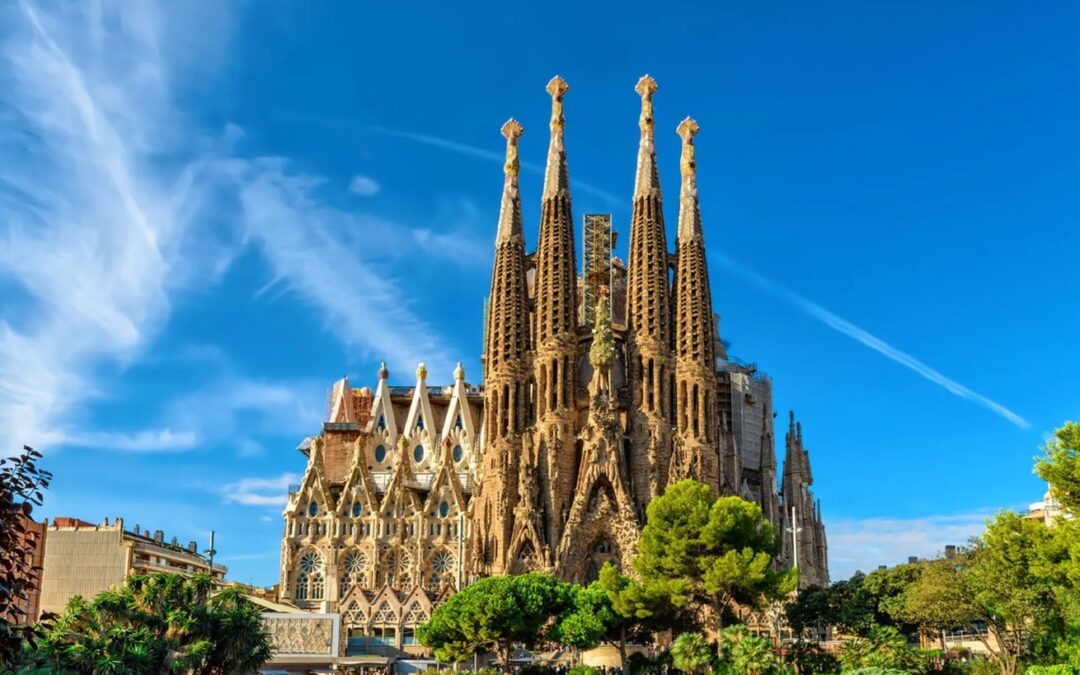Welcome to Our NEW Blog Series – WHAT THE FACT?
The architectural styles of Art Nouveau, Catalan Modernism (Modernista), and Spanish Late Gothic are all beautifully combined in the Sagrada Familia[1][2]. The project was modified by Antoni Gaudí’s unique vision, which balanced the original Neo-Gothic design to create a building that didn’t require exterior buttressing or internal bracing to stand on its own[3].
The outcome of Gaudí’s design is a hyperbolic paraboloid roof, hyperboloid vaults and sidewalls, and a complexly symbolic forest of helicoidal piers[3]. By building an Expressionist vision of a 20th-century cathedral, he employed visual symbolism to explain the secrets of the Christian faith[3].
The Beginning
Josep Maria Bocabella, a local bookseller, came up with the concept for the Sagrada Familia in 1874. After visiting the Vatican, Bocabella got the idea to build a large church honoring the Holy Family. Under the guidance of architect Francisco de Paula del Villar, construction started on March 19, 1882[6]. But in less than a year, Gaudí assumed leadership as the principal architect, revolutionizing the project with his own design that combined Art Nouveau shapes with Gothic architecture[7].
Views and Reactions
The Sagrada Familia is unquestionably a famous work of art that brilliantly displays Gaudí’s architectural talent[4], but its distinctive style has not been without controversy. Certain aspects of the current design, which was created using elements that survived and were rebuilt after Gaudí’s passing, have drawn criticism[3].
Millions of people visit the Sagrada Familia each year in spite of this, making it one of Barcelona’s most well-known landmarks[1][3]. In its urban location, its twisted towers and daring flying buttresses provide an unusual sight[3].
Gaudí’s Commitment and Setbacks
Gaudí lived on-site in his final years, dedicating the rest of his life building the Sagrada Familia. But because it was all dependent on private donations, progress was sluggish[7]. Less than 25% of the project was finished when Gaudí passed away tragically in 1926[7].
The 1936 Spanish Civil War was a major setback for the project. The crypt was set on fire by FAI anarchists, who also destroyed many of Gaudí’s original models and plans[7]. Under Francesc de Paula Quintana’s guidance, work was able to resume in 1939[7] after these plans were rebuilt using images and published information.

Contemporary Development and Finalization
Technological developments like computer-aided design and computerized numerical control (CNC) in the second part of the 20th century have made progress faster[7]. 2000 saw the completion of the central nave vaulting, which was covered in 2010[4]. A number of bell towers and the façades depicting the Passion and Nativity have also been finished[7][9].
The Virgin Mary skyscraper will be dedicated in December 2021, after work resumed after a brief stop in 2020 owing to the COVID-19 pandemic[6]. 2026, the year of Gaudí’s centennial, is when the church’s remaining towers and most of its construction are expected to be finished[8].
A Combination of the Ancient and the Modern
Modern building techniques have expedited the process, but Gaudí’s original concept for the Sagrada Familia has not changed. Reconstructed versions of the original blueprints and contemporary modifications serve as the foundation for the current design[7]. The outcome is a magnificent fusion of cutting-edge engineering and ageless artistry that never fails to enthrall tourists from all over the world.
The history of the Sagrada Familia is one of tenacity, devotion, and creativity. The basilica is a monument to the eternal power of creativity, religion, and human ingenuity as it approaches completion.

Worldwide Acknowledgment
In 1984, the crypt of the Sagrada Familia and the Nativity facade, among other works by Gaudí, were recognized as outstanding universal values when they were inducted as UNESCO World Heritage sites[3]. Gaudí’s architectural contributions are highly valued and appreciated globally, as evidenced by this classification.
The distinctive architectural design of the Sagrada Familia, which combines modern and medieval features, never fails to enthrall tourists from all over the world. There is no doubting the church’s standing as an exceptional work of art that shifts depending on your perspective, even though opinions may differ[5].
Citations:
[1] https://sagradafamilia.barcelona-tickets.com/sagrada-familia-tower-architecture/
[2] https://architectuul.com/architecture/sagrada-familia
[3] https://www.britannica.com/topic/Sagrada-Familia
[4] https://sagradafamilia.barcelona-tickets.com/about-sagrada-familia/
[5] https://sagradafamilia.org/documents/20142/1000561/Booklet_04.pdf/5eb8514a-7bd2-77d0-15dc-9c9c0315cf23
[6] https://sagradafamilia.org/en/history-of-the-temple
[7] https://en.wikipedia.org/wiki/Sagrada_Fam%C3%ADlia
[8] https://sagradafamilia.barcelona-tickets.com/history-of-sagrada-familia/
[9] https://www.britannica.com/topic/Sagrada-Familia
[10] https://www.cityexperiences.com/blog/storied-history-sagrada-familia/

